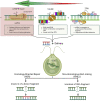Genetic engineering to enhance microalgal-based produced water treatment with emphasis on CRISPR/Cas9: A review
- PMID: 36714622
- PMCID: PMC9881887
- DOI: 10.3389/fbioe.2022.1104914
Genetic engineering to enhance microalgal-based produced water treatment with emphasis on CRISPR/Cas9: A review
Abstract
In recent years, the increased demand for and regional variability of available water resources, along with sustainable water supply planning, have driven interest in the reuse of produced water. Reusing produced water can provide important economic, social, and environmental benefits, particularly in water-scarce regions. Therefore, efficient wastewater treatment is a crucial step prior to reuse to meet the requirements for use within the oil and gas industry or by external users. Bioremediation using microalgae has received increased interest as a method for produced water treatment for removing not only major contaminants such as nitrogen and phosphorus, but also heavy metals and hydrocarbons. Some research publications reported nearly 100% removal of total hydrocarbons, total nitrogen, ammonium nitrogen, and iron when using microalgae to treat produced water. Enhancing microalgal removal efficiency as well as growth rate, in the presence of such relevant contaminants is of great interest to many industries to further optimize the process. One novel approach to further enhancing algal capabilities and phytoremediation of wastewater is genetic modification. A comprehensive description of using genetically engineered microalgae for wastewater bioremediation is discussed in this review. This article also reviews random and targeted mutations as a method to alter microalgal traits to produce strains capable of tolerating various stressors related to wastewater. Other methods of genetic engineering are discussed, with sympathy for CRISPR/Cas9 technology. This is accompanied by the opportunities, as well as the challenges of using genetically engineered microalgae for this purpose.
Keywords: CRISPR/cas9; bioremediation; genetic engineering; microalgae; produced wastewater.
Copyright © 2023 Hassanien, Saadaoui, Schipper, Al-Marri, Dalgamouni, Aouida, Saeed and Al-Jabri.
Conflict of interest statement
The authors declare that the research was conducted in the absence of any commercial or financial relationships that could be construed as a potential conflict of interest.
Figures


Similar articles
-
Phytohormones as a novel strategy for promoting phytoremediation in microalgae: Progress and prospects.J Environ Manage. 2025 Jan;373:123593. doi: 10.1016/j.jenvman.2024.123593. Epub 2024 Dec 6. J Environ Manage. 2025. PMID: 39644554 Review.
-
Advancement on mixed microalgal-bacterial cultivation systems for nitrogen and phosphorus recoveries from wastewater to promote sustainable bioeconomy.J Biotechnol. 2022 Dec 10;360:198-210. doi: 10.1016/j.jbiotec.2022.11.008. Epub 2022 Nov 19. J Biotechnol. 2022. PMID: 36414126 Review.
-
Microalgae for bioremediation: advances, challenges, and public perception on genetic engineering.BMC Plant Biol. 2024 Dec 27;24(1):1261. doi: 10.1186/s12870-024-05995-5. BMC Plant Biol. 2024. PMID: 39731038 Free PMC article. Review.
-
Sustainable microalgal biomass valorization to bioenergy: Key challenges and future perspectives.Chemosphere. 2022 Jun;296:133812. doi: 10.1016/j.chemosphere.2022.133812. Epub 2022 Feb 9. Chemosphere. 2022. PMID: 35149012 Review.
-
Microalgae-based advanced municipal wastewater treatment for reuse in water bodies.Appl Microbiol Biotechnol. 2017 Apr;101(7):2659-2675. doi: 10.1007/s00253-017-8184-x. Epub 2017 Feb 17. Appl Microbiol Biotechnol. 2017. PMID: 28213735 Review.
Cited by
-
Microbial lipid-based biodiesel production using wastewater: opportunities and challenges.Bioresour Bioprocess. 2025 Jul 4;12(1):70. doi: 10.1186/s40643-025-00897-2. Bioresour Bioprocess. 2025. PMID: 40613951 Free PMC article. Review.
-
A synthetic biology approach for the treatment of pollutants with microalgae.Front Bioeng Biotechnol. 2024 Apr 5;12:1379301. doi: 10.3389/fbioe.2024.1379301. eCollection 2024. Front Bioeng Biotechnol. 2024. PMID: 38646010 Free PMC article. Review.
-
Review on the impact of heavy metals from industrial wastewater effluent and removal technologies.Heliyon. 2024 Nov 15;10(23):e40370. doi: 10.1016/j.heliyon.2024.e40370. eCollection 2024 Dec 15. Heliyon. 2024. PMID: 39654720 Free PMC article. Review.
-
Challenges and potential solutions of microalgae-based systems for wastewater treatment and resource recovery.Front Bioeng Biotechnol. 2023 Jun 5;11:1210228. doi: 10.3389/fbioe.2023.1210228. eCollection 2023. Front Bioeng Biotechnol. 2023. PMID: 37342510 Free PMC article. No abstract available.
-
The Strategies Microalgae Adopt to Counteract the Toxic Effect of Heavy Metals.Microorganisms. 2025 Apr 25;13(5):989. doi: 10.3390/microorganisms13050989. Microorganisms. 2025. PMID: 40431162 Free PMC article. Review.
References
-
- Ahmad I., Abdullah N., Koji I., Yuzir A., Mohamad S. E. (2021). Potential of microalgae in bioremediation of wastewater. Bull. Chem. React. Eng. 16, 413–429. 10.9767/bcrec.16.2.10616.413-429 - DOI
-
- Ahmad I., Abdullah N., Koji I., Yuzir A., Mohamad S. E. (2021). Potential of microalgae in bioremediation of wastewater. Bull. Chem. React. Eng. Catal. 16, 413–429. 10.9767/bcrec.16.2.10616.413-429 - DOI
-
- Al-Ghouti M. A., Al-Kaabi M. A., Ashfaq M. Y., Da’na D. A. (2019). Produced water characteristics, treatment and reuse: A review. J. Water Process Eng. 28, 222–239. 10.1016/j.jwpe.2019.02.001 - DOI
-
- Al-Jabri H., Das P., Khan S., Thaher M., Abdulquadir M. (2021). Treatment of wastewaters by microalgae and the potential applications of the produced biomass—A review. WaterSwitzerl. 13, 27. 10.3390/w13010027 - DOI
Publication types
LinkOut - more resources
Full Text Sources

